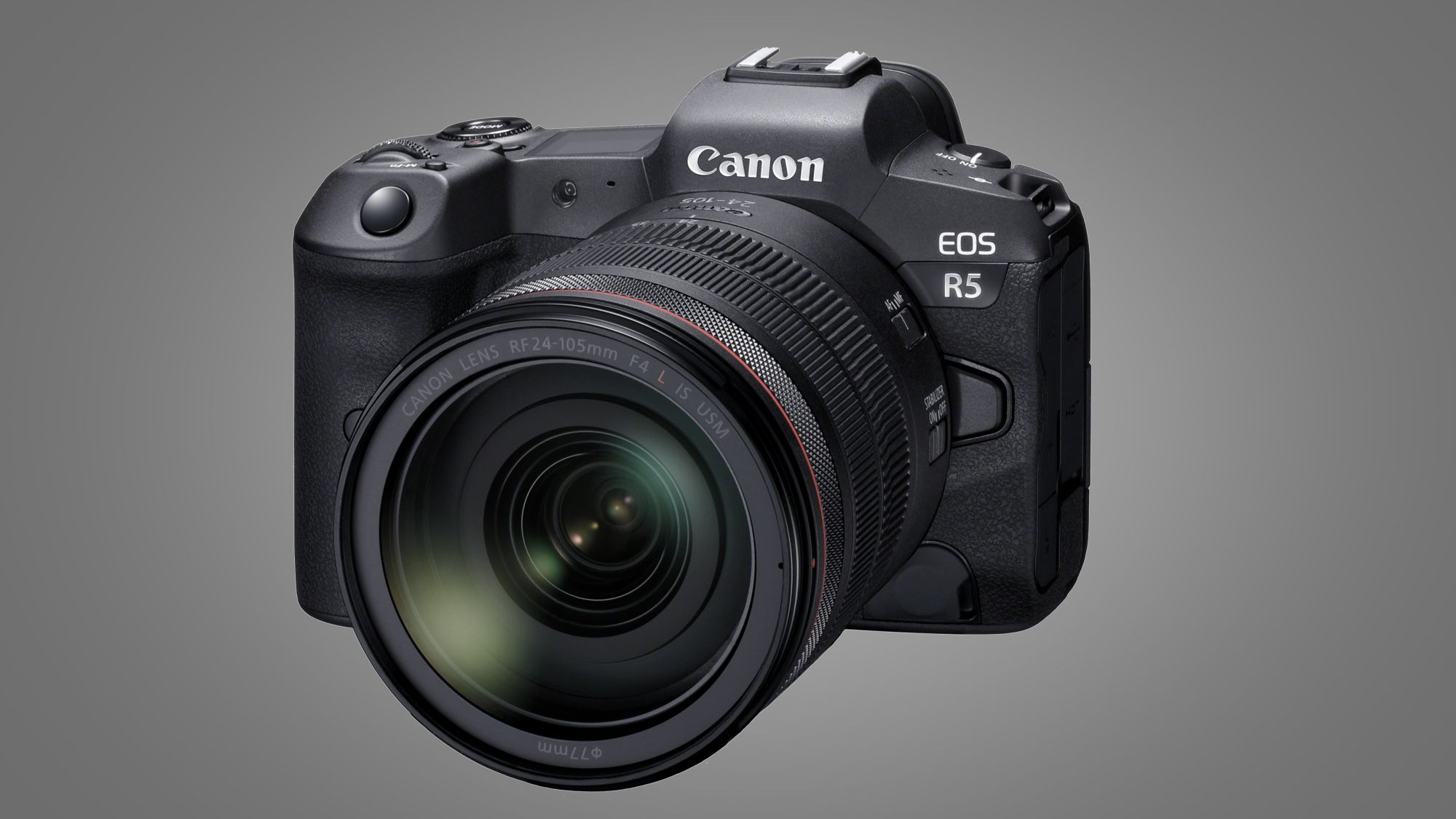You are using an out of date browser. It may not display this or other websites correctly.
You should upgrade or use an alternative browser.
You should upgrade or use an alternative browser.
Canon announces development of the EOS R5 full-frame mirrorless camera
- Thread starter Canon Rumors
- Start date
No kidding, I might switch brands just to spite Canon for taking so long.SInce this announcement time has seemingly come to a stand still for me lol.
Are we there yet?
Upvote
0
Just because it doesn't say 24fps (at this point) doesn't mean it wont be there. It will be in the R5. Just wait for the full announcement in a couple months.Video noob question. When I see a listed spec like say 4k @ 30 fps no crop, I often see wishes that they also have 24 fps. Isn't 24 fps easier to do than 30fps? Why wouldn't the slower fps always be an included option if its something so in demand?
Upvote
0
Another point indicating suggesting I should reconsider my non-use of sun shades!
But seriously, how many hours of direct sunlight does a lens element receive compared to, say, an automotive headlight?
In the telescope world, we but a scope and intend to keep it for a lifetime, knowing that the coating efficiency will decline in the early years. (And we might even be paying a premium for enhanced coatings that can't be recoated.) If a sideline sports pro sees a virtually undetectable 10% light loss in 10 years of active work, that seems economically minuscule.
It depends on the polymer.
For instance, pure acrylic polymer is UV transparent and therefore doesn't absorb UV radiation. This makes the polymer tremendously weatherable in its natural state. Unfortunately nearly all acrylic pieces you see are NOT pure, but contain various levels and types of impact modifiers as natural acrylic is very brittle. Those modifiers have to be protected with UV absorbing additives and/or free radical scavengers to provide longevity.
Polycarbonate (which is the polymer most often used in headlights) has a lot of inherent impact strength but is NOT UV transparent and doesn't weather nearly as well as acrylic based compounds. Typically you can look for about 7 years life before physical properties begin to degrade, like in bullet proof applications. They are heavily stabilized for exterior applications.
I have no knowledge regarding the composition of lens coatings, so have nothing to offer there.
Upvote
0
Harry is a character. A little Harry is very entertaining and even very thought provoking. To much Harry can be like heartburn after overeating. Some have had a lot of Harry over many months and have heart burn, while others are just starting the meal. All I can say is enjoy Harry and take him with a grain of salt. Or, ignore him or have a good laugh or ... I don't know.
Regardless, Harry is a Character! Used in moderation, quite harmless.
Jack
Regardless, Harry is a Character! Used in moderation, quite harmless.
Jack
Upvote
0
Very good. but Acryllic will go yellow in 3-5 years from new due to UV exposure in outdoors resulting in yellowish tint on images taken with your super lens. Harry. this is not a good idea..
The long-term usage of eyeglass lenses (not usually made from Acrylic) that often receive far more UV exposure than camera lenses suggests this might not be a big concern. My assumption is that there are less UV sensitive materials (or protective measures) that might cost a little more, but still affordable material cost compared to the other manufacturing costs.
And in the era of in-camera corrections, a white balance adjustment for the slight loss of blue transmitted would be a snap.
But only if you wanted the miracle lens that is twice as fast, half the weight, and half the cost. Which reminds me of why people accept poorer quality voice transmissions from cell phones (and modern land lines) compared to the quality of land lines a generation ago: other benefits outweigh.
Upvote
0
Another point indicating suggesting I should reconsider my non-use of sun shades!
But seriously, how many hours of direct sunlight does a lens element receive compared to, say, an automotive headlight?
In the telescope world, we but a scope and intend to keep it for a lifetime, knowing that the coating efficiency will decline in the early years. (And we might even be paying a premium for enhanced coatings that can't be recoated.) If a sideline sports pro sees a virtually undetectable 10% light loss in 10 years of active work, that seems economically minuscule.
Astronomy
I see we have some passions in common. Astronomy is a big one for me also. I see you seem to have a Questar 7', I have the Questar 3.5' field version. a Takahashi Mewlon 210, and triplet apochromat 80mm from Meade.
I would expect the coatings used for Questar telescope, so Maksutov-Cassegrain optical scheme, to be very strong and very durable on the elliptical lens that closes the telescope tube. For this glass part of the telescope coatings should be very strong. On a Takahashi, which is simple modified Cassegrain, so no lens that closes the telescope tube, the coating is only on the mirror and maybe not UV treated.
Ink Jet Paper UV treated
I know a bit the protocol for UV durable products in other industries like Ink Jet Papers used to print photographies. I worked in this field 15 years ago and it was a bit at its beginning. Meanwhile, the protocol is quite strict and a clear approach is testing papers under harsh UV conditions, from these results the paper industry is promising a paper that would keep the picture for 100 years or so.
Obviously, the whole approach only started 15-20 years ago for the Ink Jet Paper and nobody can confirm for sure what happens in 100 years of daylight.
However, the conditions are really harsh and we have all seen the incredible improvement in quality of Ink Jet Papers for producing our pictures taken with Canon cameras. The promise from the industry is a prediction from a calculation based on harsh testing.
The UV technology used inside the coatings of an Ink Jet Paper should not be very different from what you see in other coatings ie glass or polymers or paints coatings. It is a always a multilayer coatings and certain layer are dedicated to capture UV light through a chemical reaction, stop radicals (the products of such a chemical reaction). Chemistries might change from one application to another but methods to stop UV light consequences are similar or the same.
Check the link from BASF, I had put on another post. Also the one Harry had put from Wikipedia.
Upvote
0
Some really high end German-made CNC machines get down to 0.0005 of a millimetre or even better on any 3D-XYZ axis so it's getting better by the year!
In terms of polishing you can now automate it to such a degree, that laser-interferometry can now be used to gauge perfect curvature and/or flatness on a lens and repeat that perfect dimensioning over-and-over on EVERY lens in the production line. You need to "dope" the Acrylic or Polycarbonate with other elements in order to reduce "glass creep" and expansion/contraction issues BUT it is now possible to create in 2020 a high quality video and stills photo-centric lenses that are ON PAR with and even outperform fluorite glass elements. They will definitely be half-the-weight! The science of anti-scratch, polarization and anti-reflective surface coatings is what brings up the "plastic" lenses to glass-lens potential.
Again, a company like SIGMA definitely HAS the ability to make Acrylic or Polycarbonate still photo and cinema lenses... they just have to spend some money on the CNC machining technology and coating technology!
I HIGHLY SUGGEST the Kern Pyramid Nano for long-term precision serial production-level machining: (i.e. +/- 0.3 microns variance!) since it can do 500 mm by 500 mm plates of lens material, so that's about 50 to 100 lens elements in ONE RUN at ultra high precision! It would pay for itself in less than three months! Get TWENTY of these machines and SIGMA (or Canon!) could make SUPER-FAST compound curve Polycarbonate/Acrylic plastic lenses in batch-after-batch, enough to fulfill EVERY sales lead!
.jpg)
Flexible Maschinen für die Serienfertigung | KERN Microtechnik GmbH
KERN steht für flexible Maschinen für die Serienfertigung. Hierfür bieten wir individuelle Lösungen mit höchster Qualitätssicherheit.www.kern-microtechnik.com
(Scroll down to the KERN Pyramid Nano machine)
ALL of the current Sigma Art-series Prime and Zoom lenses would be HALF the weight and about 5% to 10% FASTER than any of their current glass! I would PERSONALLY have no issue to spending the money on a FAST SIGMA plastic lens if it has a decent anti-scratch coating (i.e. thin film vapour deposited sapphire!) AND was even only 5% faster than the glass Art series primes and zooms! The weight savings alone would make them worthwhile!
--
Hello,
and thanks for sharing further details!
While I am not familiar with the technique, I have some general questions/remarks:
You quote a CNC precision of "0.0005 of a millimetre". This is 500 nano meters. I know that highly even surfaces like lensess/mirrors have: Their surface is even to a few atomic layers which amounts to 10 nano meter and below. So, there is still a factor of 50x between this and the 500 nano meter a CNC can do.
My point: Still, a polishing step would be needed. And each of those steps is costly. At the, I am not sure how much the cost advantage would be?
I do understsnd that weight is a big advantage on its own that could justify such lenses.
Upvote
0
The R5 will make its public debut at The Photography Show(UK) 14 March.
Can you provide the source of your info?
And does "public debut" mean its in stores shortly after?
Seems this party is happening earlier than we all thought .... ;-)
Upvote
0
One question to think about is how many people are ready to jump into mirrorless at the 5 level. Also most potential buyers are going to have pretty good cameras already, so another question is how happy they are with what they have now.
You ask: "question is how happy they are with what they have now"
I would say that even if someone is 100% happy with what they have, they would still switch if they see innovations they have not not seen before and that would improve their photography in the one or the other way ...
Upvote
0
No kidding, I might switch brands just to spite Canon for taking so long.
Then you harm yourself, not Canon ...
Upvote
0
The R5 will make its public debut at The Photography Show(UK) 14 March.
Are you guessing at this or do you have real information?
Upvote
0
Are you guessing at this or do you have real information?

Canon EOS R5 will make its public debut at The Photography Show in March
Your first chance to see the incoming mirrorless powerhouse
Upvote
0
Fair enough. To be accurate, I should have said people who are happy with what they have already, even with the availability of an R5 at whatever price Canon is charging for it.You ask: "question is how happy they are with what they have now"
I would say that even if someone is 100% happy with what they have, they would still switch if they see innovations they have not not seen before and that would improve their photography in the one or the other way ...
Upvote
0
The R5 will make its public debut at The Photography Show(UK) 14 March.
Yep saw that. Completely my opinion but I am feeling like they will market and make pre sales available for the R5 first, before shedding more light on the R6. Although, both may launch together. But to me it will be sensible to make the more expensive R5 available for pre sale orders first.
Upvote
0
What's the consensus on flicker reduction? It's an option in my RP that I've never taken advantage of. Does it actually work?
It works well if the flicker is at 100 hertz or 120 hertz (or their multiples). It's revolutionized my keeper rate and post processing workflow under typical high school and small college football/baseball/gym lights. Not only is color consistent from shot to shot, so most images can be batch processed, but the shutter release is timed at the peak of the lights, so it can give a 1/2 to 2/3 stop faster Tv for the same ISO and Av. If light from more than one light tower in different phases are both illuminating areas in the frame, then the shutter is usually synced to the brightest source at its peak, but it is less effective in such cases.
Bryan at The-Digital-Picture wrote an article about it a while back when it first came out with the 7D Mark II.
Upvote
0
Yeah, I have a feeling that the 7DII is going to hold its current value for awhile. Similar to the 1D IV -- which only recently dropped in value on the used market.
I'll use the one I've got until the wheels fall off. Ditto with any others I buy. When I'm done with them there won't be much left to sell.
Upvote
0
Fair enough. To be accurate, I should have said people who are happy with what they have already, even with the availability of an R5 at whatever price Canon is charging for it.
You ask an excellent question. Especially for an amateur like me.
If I would only shoot stills, I think I would not look at a new body.
I bought the Canon 60D with the idea of using it in still and video. This is an excellent body.
It has some limits in low light and this was a bit of a problem for me as I shoot some conferences for my job and also some low light photos in general.
I love this special feeling given by light just before sunset, called in French "between dogs and wolves".
However, it had been a step change versus my Canon 350D, mostly used for astronomy pictures.
I also love art and normally I am visiting 80% of the key exhibitions in Paris, France.
Indeed, some exhibitions are simply fantastic and gather master pieces I might only see once in my life. So I like to have a picture of it.
What I do is that I take the pictures of the full exhibition when authorized. Again low light is the problem with exhibitions.
When the 6D was at the end of its official sales life, the price was divided by 2 and I bought it.
I really enjoy its capacity in low light.
What remained a frustation on my side is the lack of high resolution quality in video.
The stills with both bodies are fantastic but the video quality not that great at all in comparison with a Lumix GH5 or GH4.
I also have a Canon XA30 which I thought would produce better video quality but it is not really the case.
Canon XA30 is a perfect video camera for interviews, conferences and documentaries where you do not have time. Easy to use, lots of automatic help.
But when you have time, you put a tripod on a seaside for the world championship of windsurf, you are dreaming of fabulous high resolution videos and NO they are just ok. The video quality is not detailled oriented and this is annoying. Contrary to Lumix GH5 (again).
So I bought in 2018 during Black Friday the Lumix FZ1000 where I get this high resolution video camera, but it is a bridge and all my L lenses can not be used... However, video quality is impressive. FZ1000 is kind of a small GH4 with IBIS !
So Canon R5 might be the body I am hopping to find: excellent stills but also excellent videos quality.
Where my Canon lenses could be used...
If the video quality is not there, I will not buy it. I will continue with my current bodies.
Attached: exhibition on the French art during François 1st (16th century) Body 6D


Brand new streets and shops in my district: Body 6D



I hope it clarifies why people like me are interested in such a body.
Last edited:
Upvote
0
Similar threads
- Replies
- 9
- Views
- 900
- Replies
- 64
- Views
- 17K
- Replies
- 3
- Views
- 1K
- Replies
- 96
- Views
- 13K
